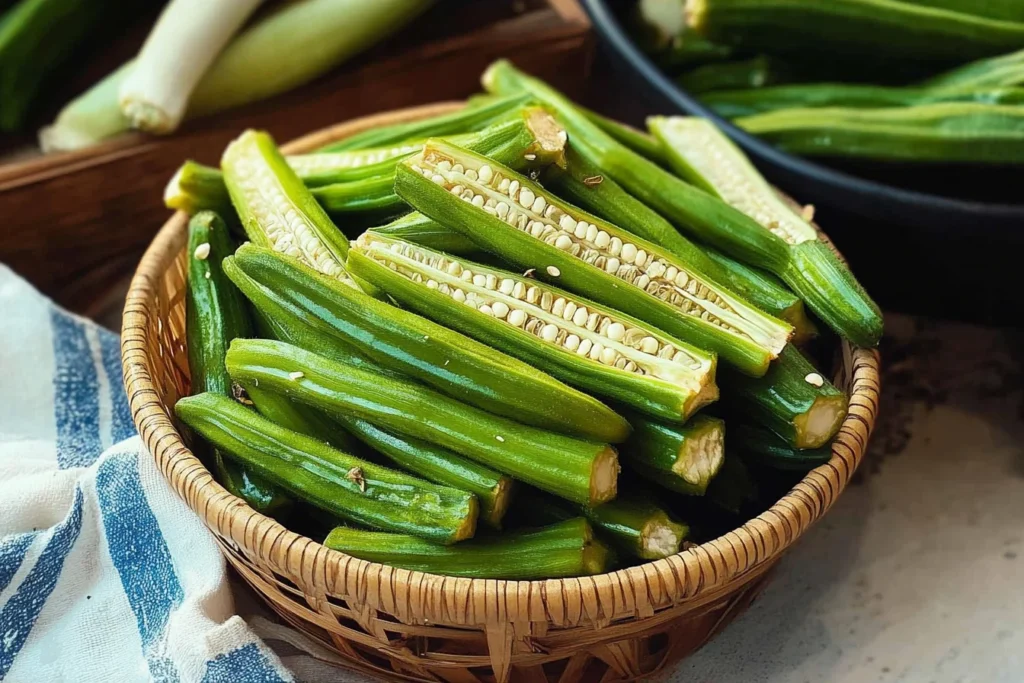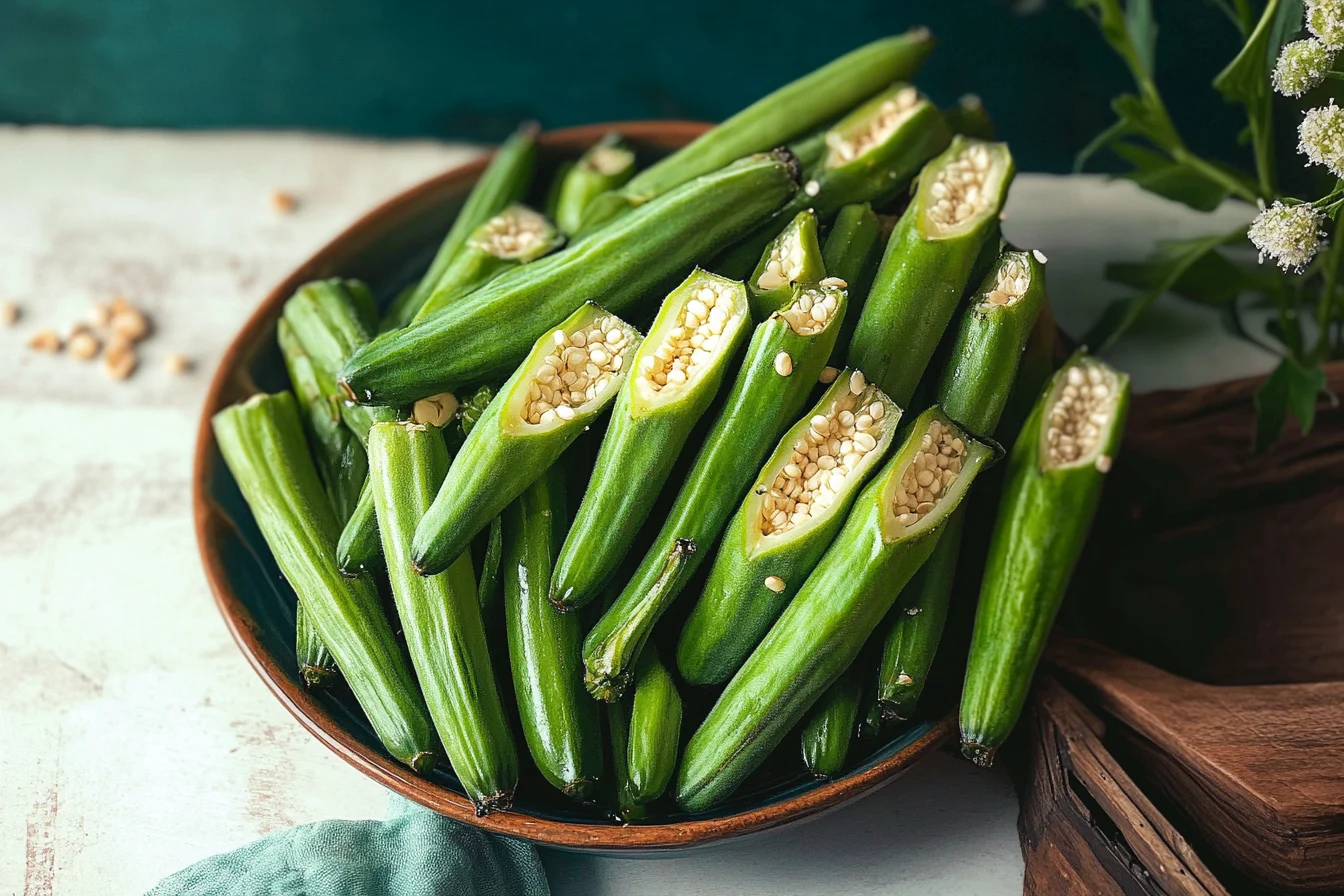Boiled okra recipe is a simple yet nutritious dish that involves cooking fresh or frozen okra pods in water until tender. This method preserves the vegetable’s natural flavor and nutritional benefits, making it a staple in many cuisines worldwide. Known for its mild taste and slightly slimy texture, boiled okra is a versatile dish that can be seasoned or paired with a variety of meals.

Whether served as a side dish or incorporated into stews and soups, boiled okra is a healthy and delicious option.
The Origins and History of Cooking Okra
Okra, also called lady’s fingers, has a rich history tracing back to Africa. It was brought to the Americas and Asia through trade routes and quickly became an integral part of local cuisines. In Southern cuisine, okra gained prominence due to its adaptability and ability to thrive in warm climates.
Globally, boiled okra has been enjoyed in dishes such as:
- Gumbo in the Southern U.S.
- Bhindi Masala in India.
- Okra Soup in West Africa.
Okra in Global Culinary Traditions
The versatility of okra makes it a favorite in various culinary traditions:
- Africa: Used in hearty stews and soups.
- India: Often fried or added to curries and stir-fries.
- United States: A key ingredient in Creole and Cajun dishes, especially gumbo.
Each region adapts okra to its unique flavors and cooking methods.
Nutritional Benefits of Okra
Vitamins, Minerals, and Fiber in Okra
Okra is packed with essential nutrients, including:
- Vitamins: High in vitamin C, K, and folate.
- Minerals: Contains magnesium, calcium, and potassium.
- Fiber: Supports digestion and promotes gut health.
Additionally, okra’s low-calorie content makes it ideal for weight-conscious individuals.
Why Boiling Preserves Nutritional Value
Boiling okra is one of the healthiest ways to prepare it. Unlike frying, boiling retains its:
- Water-Soluble Vitamins: Such as vitamin C and folate.
- Fiber Content: Essential for maintaining digestive health.
For maximum benefits, avoid overboiling, as it can reduce the potency of its nutrients.
Common Myths About Boiled Okra
Debunking the “Sliminess” Misconception
The slime in okra, called mucilage, is often misunderstood. While some dislike it, the mucilage is:
- Nutrient-Rich: A source of soluble fiber.
- Easily Managed: Use techniques like quick boiling or adding acidic ingredients (e.g., lemon juice) to reduce it.
How to Enhance the Flavor of Boiled Okra
Simple steps can elevate the flavor of boiled okra:
- Add salt during cooking for enhanced taste.
- Finish with lemon juice or vinegar for tanginess.
- Toss in spices like garlic powder or cayenne for a bold twist.
Ingredients Needed for Basic Boiled Okra
Fresh vs. Frozen Okra: Which Is Better?
- Fresh Okra:
- Preferred for its crisp texture and vibrant flavor.
- Look for bright green, unblemished pods.
- Frozen Okra:
- Convenient and available year-round.
- Works just as well in boiled recipes, though slightly softer when cooked.
Essential Additives: Salt, Lemon, and Optional Spices
The beauty of boiled okra lies in its simplicity. Key ingredients include:
- Okra Pods: Fresh or frozen.
- Salt: Enhances natural flavors.
- Lemon Juice: Balances the sliminess and adds brightness.
- Optional Spices: Garlic, pepper, or cayenne for extra flavor.
Step-by-Step Guide to Cooking Boiled Okra
How to Make Perfect Boiled Okra
Boiling okra is one of the simplest ways to prepare this nutritious vegetable. Whether you’re new to cooking okra or looking for tips to perfect your recipe, this step-by-step guide will ensure a delicious result every time.
Preparing Okra for Boiling
Washing and Trimming Okra Pods
Proper preparation starts with cleaning and trimming the okra:
- Wash Thoroughly: Rinse okra pods under cold running water to remove dirt and debris.
- Dry Completely: Pat them dry with a clean kitchen towel to prevent excess water from affecting the cooking process.
- Trim the Ends: Use a sharp knife to remove the tough stem and tip without cutting into the pod itself to preserve its juices.
Tips for Reducing Sliminess in Boiled Okra Recipe
To manage okra’s natural mucilage:
- Quick Boil: Avoid prolonged cooking, as it increases the release of mucilage.
- Acidic Additives: Add a splash of lemon juice or vinegar to the boiling water to cut down the slime.
- Avoid Overcrowding: Cook in small batches to ensure even cooking and reduced mucilage release.
Cooking Boiled Okra Step-by-Step
How Long to Boil Okra for Optimal Texture
Boiling times vary based on your preferred texture:
- For tender-crisp okra: Boil for 3–4 minutes.
- For softer okra: Boil for 6–8 minutes.
Keep an eye on the pods, as overcooking can result in mushiness.
Adding Flavors During Boiling: Herbs and Spices
Enhance the flavor of your okra during the cooking process:
- Add salt and a pinch of pepper to the boiling water.
- Toss in garlic cloves, bay leaves, or a sprig of thyme for subtle herbal notes.
- Experiment with spices like cumin seeds or paprika for a bold twist.
Testing for Doneness
To check if the okra is cooked:
- Insert a fork or knife into a pod.
- It should slide in easily but still hold its shape.
- Taste a piece to ensure it meets your desired level of tenderness.
Once done, drain the okra and serve immediately to preserve its vibrant green color.
Variations on the Classic Boiled Okra Recipe
Boiled okra can be prepared in countless ways to suit your taste preferences and meal plans. Here are a few variations to try:
Southern-Style Boiled Okra Recipe
In the Southern U.S., boiled okra is often served simply with butter and a sprinkle of salt.
- Ingredients:
- Fresh okra pods.
- Butter (optional) and salt for serving.
- Preparation:
- Boil the okra as instructed.
- Toss with melted butter and season generously with salt.
This comforting preparation pairs well with fried chicken or cornbread.
Boiled Okra with Garlic and Lemon
For a zesty, garlicky twist, try this variation:
- Ingredients:
- Okra pods, minced garlic, and fresh lemon juice.
- Preparation:
- Add garlic to the boiling water alongside the okra.
- Drizzle with fresh lemon juice before serving.
The acidity of the lemon complements okra’s earthy flavor beautifully.
Spicy Boiled Okra: A Flavorful Twist
Spice lovers will enjoy this bold preparation:
- Ingredients:
- Okra, red chili flakes, and cayenne pepper.
- Preparation:
- Sprinkle chili flakes and cayenne into the boiling water.
- Finish with a drizzle of olive oil infused with additional chili.
This version adds a fiery kick to your meal, perfect for pairing with grilled meats.
Common Mistakes to Avoid When Boiling Okra
Overcooking and How It Affects Texture
Overcooking is a common issue with boiled okra. Here’s how to avoid it:
- Set a Timer: Stick to the recommended cooking times to prevent mushiness.
- Cool Quickly: If not serving immediately, plunge cooked okra into an ice bath to stop the cooking process.
Using Too Much Water: Why It Matters
Boiling okra in excessive water can dilute its flavor and nutritional value. For best results:
- Use just enough water to cover the okra pods.
- Retain some of the water (now infused with okra flavor) for soups or stews.
Serving, Pairing, and Storing Boiled Okra
How to Serve Boiled Okra
Boiled okra is a versatile dish that can be served in various ways, depending on the occasion and meal type. Its simplicity makes it an excellent base for experimenting with flavors and textures.
Simple Seasoning Ideas for Boiled Okra Recipe
Boiled okra shines with minimal seasoning. Here are a few simple yet flavorful options:
Adding Butter, Olive Oil, or Vinegar for Extra Flavor
- Butter: Melted butter adds richness and enhances the natural taste of okra.
- Olive Oil: A drizzle of extra-virgin olive oil gives a fruity, slightly peppery note.
- Vinegar: Apple cider or balsamic vinegar provides a tangy balance that reduces sliminess.
Pairing Boiled Okra with Main Dishes
Boiled okra complements a variety of cuisines and dishes. Here are some pairing ideas:
- Southern Classics: Serve alongside fried chicken, mashed potatoes, or cornbread for a traditional Southern meal.
- Seafood: Pair with grilled shrimp or fish for a light, healthy dinner.
- Vegetarian Meals: Combine with sautéed greens, beans, or roasted vegetables for a wholesome plant-based plate.
Healthy Meal Ideas Featuring Boiled Okra Recipe
Okra’s nutritional benefits make it a fantastic addition to balanced, healthy meals. Here are some creative ways to incorporate it:
Boiled Okra with Rice and Beans
A classic and nutritious pairing, this dish is hearty and satisfying:
- Ingredients:
- Steamed rice, boiled okra, and black beans or kidney beans.
- Preparation:
- Season boiled okra with salt and pepper.
- Mix with rice and beans, then drizzle with olive oil or add a squeeze of lime for flavor.
Including Boiled Okra in Low-Carb Meals
For those on a low-carb diet, okra fits perfectly:
- Ingredients:
- Boiled okra, grilled chicken or tofu, and a green salad.
- Preparation:
- Serve the okra as a side dish with light dressing.
- Add avocado or nuts to the salad for a boost of healthy fats.
This meal is light, filling, and packed with nutrients.
How to Store Leftover Boiled Okra Recipe
Proper storage is essential to maintain the quality and taste of leftover boiled okra.
Refrigeration Tips for Freshness
- Storage:
- Place cooled boiled okra in an airtight container.
- Refrigerate within 2 hours of cooking to prevent spoilage.
- Shelf Life:
- Boiled okra can be stored in the refrigerator for up to 3 days.
Reheating Methods: Stovetop and Microwave
Reheating boiled okra requires care to retain its texture and flavor:
- Stovetop:
- Heat in a skillet over low-medium heat with a splash of water or broth.
- Stir gently to avoid breaking the pods.
- Microwave:
- Place in a microwave-safe dish and cover with a damp paper towel.
- Heat in 30-second intervals, stirring between intervals.
Avoid overheating to prevent the okra from becoming overly soft.
Fun Facts and Trivia About Okra
Okra’s long history and cultural significance make it a fascinating ingredient. Here are some fun facts:
The Role of Okra in Southern Cuisine
- Historical Staple: Okra has been a key ingredient in Southern cooking since its introduction in the Americas.
- Gumbo Essential: The term gumbo is derived from an African word for okra, highlighting its importance in Creole and Cajun dishes.
Okra’s Historical Importance in African and Asian Cultures
- African Origins: Okra was first cultivated in Africa and is still widely used in stews and soups across the continent.
- Asian Influence: In India, okra (known as bhindi) is often stir-fried or cooked in curries, showcasing its adaptability to bold spices and flavors.
More FAQs
- What does boiled okra taste like?
Boiled okra has a mild, earthy flavor with a slightly grassy undertone. - How do I reduce the sliminess in Boiled Okra Recipe?
Add lemon juice, vinegar, or cook quickly in small batches to minimize mucilage. - Can I use frozen okra for boiling?
Yes, frozen okra works well and is convenient. No need to thaw before boiling. - What spices pair best with Boiled Okra Recipe?
Garlic, paprika, cumin, and chili flakes are excellent choices. - Is boiled okra good for weight loss?
Yes, it’s low in calories, high in fiber, and nutrient-dense, making it a great option for weight-conscious individuals. - Can I boil okra without trimming it?
While you can, trimming the stems helps improve presentation and ensures even cooking. - What are the health benefits of boiled okra?
Boiled okra supports digestion, heart health, and immune function due to its fiber, vitamins, and antioxidants. - How do I know when okra is fully cooked?
It should be tender but still firm enough to hold its shape. Test with a fork or knife. - What can I do with leftover boiled okra?
Use it in soups, salads, or stir-fries, or enjoy it cold with a tangy dressing. - Why does okra become slimy when boiled?
The mucilage in okra is released during cooking, but it’s a natural fiber that’s both healthy and manageable with the right techniques.

Boiled Okra Recipe
Equipment
- Large pot
- Colander
- Knife
- Cutting Board
Ingredients
Main Ingredients
- 1 pound fresh okra trimmed
- 4 cups water for boiling
- 1 teaspoon salt
- 1 tablespoon butter optional, for serving
Instructions
- Bring 4 cups of water to a boil in a large pot. Add salt to the water.
- Trim the stems of the okra, being careful not to cut into the pods to prevent sliminess.
- Add the okra to the boiling water and cook for 8-10 minutes, or until tender but still slightly firm.
- Drain the okra using a colander and transfer to a serving dish.
- Optional: Toss with butter for added flavor. Serve warm and enjoy!
